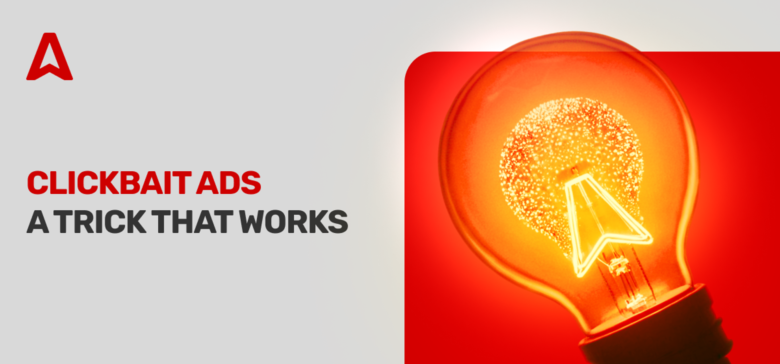Clickbait ads usually carry negative connotations because bad actors abuse them to get traffic. However, clickbait ads can be applied appropriately to get valuable website traffic and engagement. This article is a deep dive into clickbait advertising and what you should know about it.
What Is Clickbait?
Literally, clickbait means content intended to “bait” someone into clicking on it. It refers to content that encourages people to click on a webpage and read, view, or listen to what’s on the page. Clickbait headlines are sensationalized to attract engagement.
Take, for example, the clickbait ad below with the headline, This Seems Unbelievable But Happens In Dubai Everyday.

From the image, one might wonder what happens in Dubai every day. Do people take pictures every day? Are people happy every day? Do men and women wear sunglasses daily? This curiosity drives the viewer to click the link to learn more. In the end, the information could be as mundane as Dubai having many skyscrapers that people visit, but the headline makes someone click on it.
Examples of Clickbait Ads
Clickbait ads work by revealing a plot and stating that there’s more to that plot, which the viewer can see by clicking on the link. The bait lies more in the second part, enticing the viewer’s curiosity with a title like:
- “You wouldn’t believe..”
- “People are saying..”
- “[Celebrity or trusted authority] reveals valuable information..”
- “You’ll never expect this..”
- “This seems unbelievable..”
Let’s see some examples of clickbait ads in action.
Example 1
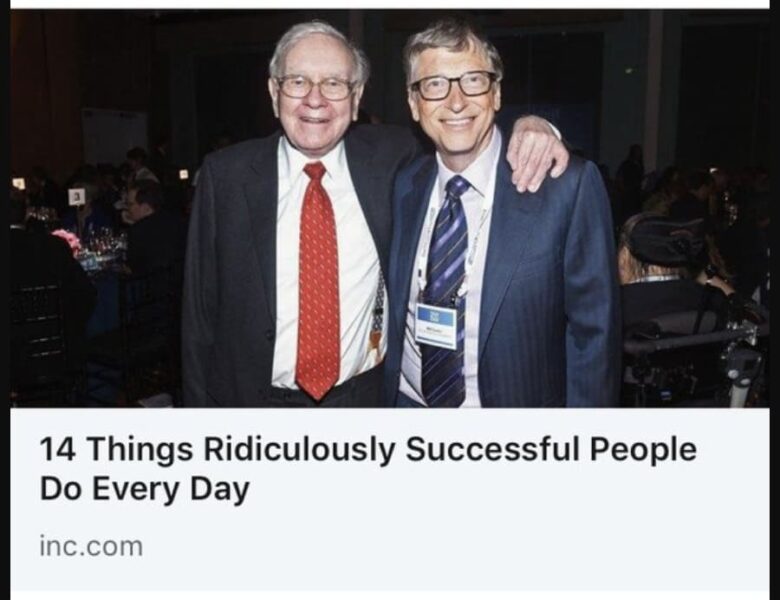
Above is a clickbait link from Inc. Magazine, a popular business publication. It uses the image of Bill Gates and Warren Buffett, two prominent billionaire entrepreneurs, to reveal a plot: 14 Things Ridiculously Successful People Do Every Day. This headline will pique the interest of business-minded people, some of whom will click on it to see the whole plot.
The Inc. article contains generic advice like “They focus on only one thing,” “They use a notebook,” “They avoid meetings at all costs,” and “They delegate almost everything.” Anyone could have written this article containing generic information for business professionals. But, they would not have gotten as much traffic as Inc. without the clickbaity headline.
Example 2

The above is another illustration of piggybacking on a successful brand or person to attract traffic. To the uninitiated, Barbara Corcoran is a prominent real estate investor who stars on Shark Tank, a TV show where aspiring entrepreneurs pitch their companies to a panel of investors.
The clickbait ad leverages a trusted authority, Barbara Corcoran, to entice users to click and read valuable information. It’s an effective strategy but with a catch. You should never attribute an untrue statement to a prominent person. When using a trusted authority to attract readers, it must be something they actually said, which you can then leverage to prove a point. Misquoting or falsely attributing a statement to a trusted authority can invite legal consequences.
Example 3
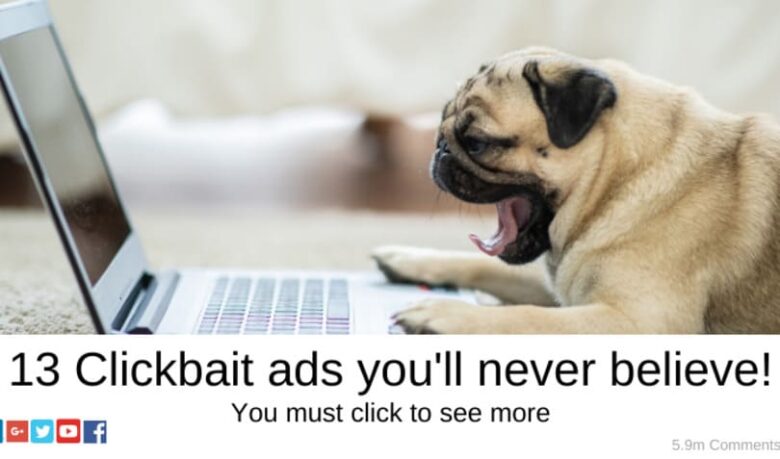
This example is funny because it teases the idea of clickbait ads to serve a clickbait ad. Truthfully, some advertisers take clickbait ads too far and invite ridicule of themselves.
Now, here’s an effective clickbait ad teasing the most ridiculous clickbait ads you can use as an example of what not to do. Of course, you must fall for the bait and click to see more, demonstrating how effective these ads can be even to the audience that serves them.
Adsterra is an ideal platform to deliver your effective catchy ads to the perfect audience. Our network includes over 35,000 publishers across various niches serving 30 billion monthly impressions. Sign up today to increase your website traffic and sales.
Why Clickbait Works?
Clickbait ads activate the brain’s curiosity gap, a fear of missing out (FOMO), and a tendency for instant gratification. These three emotional triggers make clickbait ads effective.
Curiosity gap
The curiosity gap is the difference between what a human brain knows and wants to know. Clickbait headlines trigger this gap by creating a sense of uncertainty — that there’s something the user should know but currently doesn’t. “You wouldn’t believe,” “People are saying,” and “X Shocking things” are typical phrases that trigger the curiosity gap.
The human brain naturally wants to close that gap by clicking on the headline to learn something new.
FOMO
The fear of missing out (FOMO) is self-explanatory. It’s an emotional reaction to potentially missing out on valuable information you might not be opportune to see again. Clickbait triggers this fear with headlines urging people to click to avoid missing out on something they can benefit from.
Remember our example of 14 Things Ridiculously Successful People Do Every Day. This title triggers the fear of missing out on information that could help them become more successful.
Instant gratification
Clickbait ads make viewers feel they can access easy solutions to their problems. The headlines evoke the allure of achieving excellent results with little effort, even when the reality is more complicated. For example, 14 Things Ridiculously Successful People Do Every Day makes it look like there are easy steps for people to become successful, enticing viewers to click through. But the obvious truth is that people take much more than 14 steps to succeed in any endeavor.
Disadvantages of Clickbait Ads
Clickbait ads help drive attention to your product or service but have some negative sides. If the clickbait headline isn’t followed by valuable content for your audience, you risk damaging your brand’s credibility and trust, which can be difficult to rebuild.
These are the main disadvantages of clickbait ads:
1. It can reduce your revenue
Attracting traffic is one thing, and retaining it is another. If someone clicks on your ad and doesn’t find the valuable information the headline promised, they’ll quickly exit the website and be less inclined to interact with it again.
The point of clickbait headlines is to sell your product or show ads. This point is negated if a user exits your website or landing page as quickly as they enter it.
2. It erodes credibility
Using clickbait excessively can erode trust from your audience, causing lesser traffic and sales in the long term. Building an audience requires a lot of effort, but unnecessary clickbait can ruin it fast. If people see your website as a source of truth, they’ll be appalled if you suddenly use headlines that fail to live up to their promises. If this happens for a long time, the audience will lose interest and put their trust in other websites.
3. It reduces search engine rankings
Clickbait can lead to high website bounce rates, which causes lower search engine rankings. To the uninitiated, bounce rate refers to the percentage of visitors who land on your site and leave without visiting another page. This metric measures “stickiness,” with the idea that an engaging website will compel readers to view more content. The higher a website’s bounce rate, the less likely it is to rank high on search engines. An ideal bounce rate is 40% or lower but 50% is manageable; anything 60% or higher causes search rankings to drop.
If you use clickbait without providing valuable content, visitors quickly get fed up and exit your website. In contrast, providing useful information compels visitors to click on other articles to gain more knowledge. Some visitors can also share your content on social media.
Take, for example, The Hustle, a popular business and technology newsletter. This website is known for using clickbaity headlines to attract readers. Some examples shown in the screenshot below include “The first fugitive caught by the internet,” “A startup so cool it could wake the dead,” and “Survival of the richest.”
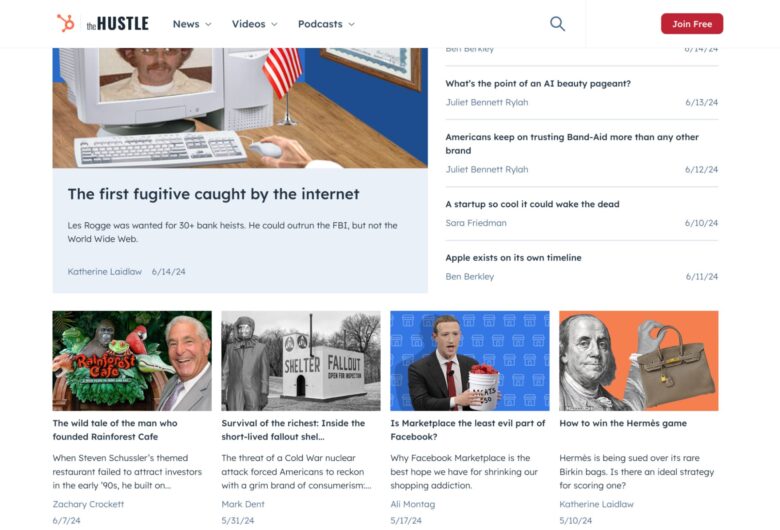
How to Use Clickbait Ads Correctly?
1. Use high-quality, attractive images
It’s advisable to use high-quality, eye-catching thumbnails to draw the user’s attention. You can use bright colors and add elements to illustrate the headline visually, like in the samples below.
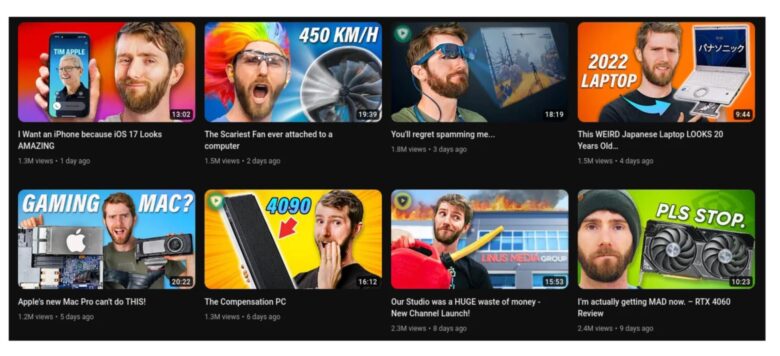
Your audience will likely see the image before the headline. Hence, high-quality, illustrative images are critical to drawing attention to your content.
2. Use attention-catching headlines
Your headlines should incorporate fascinating questions that pique the reader’s interest and sensational language that makes them want to know more about the topic. Consider these examples from The Hustle: “Les Rogge was wanted for 30+ bank heists. He could outrun the FBI, but not the World Wide Web” and “Are superstar athletes good for the economy?” The first headline sounds like a thriller anyone would be interested in, and the second is an intriguing question that makes the human brain hungry for an answer.
Adsterra lets you A/B test headlines to see which ones deliver the best results. This feature empowers publishers to get excellent conversions via trial and error. The intuitive dashboard makes it easy to monitor your campaigns and make adjustments when needed.
3. Don’t be misleading
People dislike clickbait ads because many brands use headlines that don’t truly represent their content. You should avoid being misleading so visitors don’t write you off like any other brand. Every clickbaity headline you write should be accompanied by valuable content to justify the strategy.
Catchy headlines are welcome, but Adsterra doesn’t condone misleading or fraudulent content. All clickbait ads must comply with our rules of fairness. Luckily, we are to offer you some nice alternatives! If you feel your brand won’t work well with clickbait ads, you can use ad formats like Social Bar and Native Ads to promote it in a more formal tone.
4. Don’t leverage tragedies for clickbait
Don’t use current or recent tragedies to conjure clickbait headlines. Let’s say a celebrity recently died, and you’re tempted to write a clickbaity headline related to this story, e.g., “The shocking last words of [celebrity’s name].” This strategy might seem effective at face value, but you’ll likely invite backlash and reduce your credibility. Tragedies shouldn’t be used for clickbait because this is seen in poor taste.
5. Don’t insert call-to-actions in headlines
A call-to-action (CTA) button has no place in a clickbaity headline. The headline is there to attract attention, not suggest an action for the reader. The CTA should be on the web page the reader sees after clicking the link, not the headline.

The image above illustrates how not to use a clickbait headline. A headline instructing viewers to scatter soap in their yard feels off, as no justification is provided for this action in the headline. Instead, it can be something like, “This soap has many benefits for the environment,” or “You won’t believe how this soap improves your environment.” When the user clicks on the content, you can dive deeper into the product and include a CTA button at the bottom directing users to buy the soap.
Measuring the Effectiveness of Clickbait Ads
You can measure the effectiveness of clickbait ads by paying attention to traffic and sales metrics. Any clickbait marketing strategy aims to drum up traffic and sales, and observing these metrics increase means your clickbait ads are effective. In contrast, if you observe reduced traffic and product sales, it hints at your clickbait strategy being off-putting and turning away potential customers.
Adsterra provides a detailed dashboard for monitoring ad performance metrics. From this dashboard, you can easily evaluate the effectiveness of your clickbait ads.
Conclusion
Clickbait ads can serve you well when used correctly. We’ve explained how clickbait works and provided good examples you can follow. The key is using high-quality images and attention-grabbing headlines and avoiding including misleading information.
Above all, choose a reliable advertising network that delivers your ads to the perfect audience. No matter how good your clickbait ads are, they’ll be futile if deployed on the wrong ad network. Fortunately, Adsterra is here to deliver your ads to the perfect audience. You can target ads via many factors, including browser, operating system, device format, and location. Join our network today and deploy effective ads.
